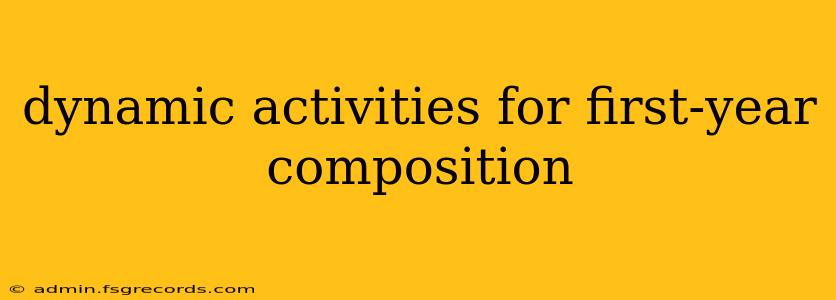First-year composition courses often face the challenge of keeping students engaged while developing crucial writing and critical thinking skills. Static lectures and rote exercises can quickly lead to disinterest. This article explores dynamic activities that invigorate the classroom, fostering a collaborative and intellectually stimulating learning environment. These strategies move beyond the traditional, emphasizing active participation and application of concepts.
Beyond the Lecture: Interactive Learning Strategies
Traditional lectures, while sometimes necessary, can be less effective than active learning strategies. Engaging students directly improves comprehension and retention. Here are several dynamic approaches:
1. In-Class Debates and Discussions:
- Focus: Critical thinking, argumentation, and communication skills.
- Method: Present a controversial topic related to the course material or current events. Divide students into teams to research and debate opposing viewpoints. Encourage respectful disagreement and evidence-based arguments. This fosters critical analysis and strengthens persuasive writing skills.
- Example: Debate the ethical implications of AI in writing, using examples from recent news and research.
2. Collaborative Writing Projects:
- Focus: Teamwork, peer review, and understanding different writing styles.
- Method: Assign group projects requiring students to collaborate on a single document, such as a research paper, a website, or a multimedia presentation. This teaches them to integrate different perspectives and navigate the complexities of collaborative writing. Establish clear roles and responsibilities within each group to ensure equitable contributions.
- Example: Collaboratively create a website analyzing a literary work, dividing tasks such as research, writing, design, and editing among group members.
3. Peer Review Workshops:
- Focus: Constructive feedback, editing skills, and understanding the writing process.
- Method: Structure peer review sessions with clear guidelines and rubrics. Encourage students to provide specific, actionable feedback, focusing on both strengths and areas for improvement. This helps students learn to evaluate their own writing more effectively.
- Example: Implement a structured peer review process where students use a rubric to evaluate specific aspects of their peers’ essays, focusing on thesis statements, argumentation, and evidence.
4. Interactive Games and Simulations:
- Focus: Engaging with concepts in a playful and memorable way.
- Method: Incorporate games that reinforce course concepts. For example, a vocabulary building game, a grammar challenge, or a simulation of a real-world writing scenario. These activities can make learning fun and relatable.
- Example: Use online platforms or create customized games that test students’ understanding of rhetorical devices or argumentative structures.
Harnessing Technology for Dynamic Learning
Technology provides powerful tools to enhance engagement and learning in first-year composition:
5. Online Discussion Forums:
- Focus: Asynchronous communication, developing arguments, and expanding perspectives.
- Method: Utilize learning management systems (LMS) or dedicated platforms for online discussions. Pose thought-provoking questions related to course readings or lectures, encouraging students to engage in respectful debate and build upon each other’s ideas. This extends learning beyond the classroom.
- Example: Prompt discussions on the ethical implications of plagiarism or the impact of social media on communication.
6. Digital Storytelling Projects:
- Focus: Creativity, narrative development, and digital literacy.
- Method: Assign projects that utilize various digital media, such as videos, podcasts, or interactive presentations. This allows students to express their creativity and explore different forms of communication while honing their storytelling abilities.
- Example: Create a short documentary film analyzing a social issue or a podcast interviewing individuals with unique perspectives.
Conclusion: A Holistic Approach to Engagement
Implementing these dynamic activities significantly improves student engagement and fosters a more effective learning environment. By moving beyond traditional methods and embracing active learning strategies, instructors can empower students to become confident and critical writers, prepared for the demands of higher education and beyond. Remember to consistently assess and adapt your methods based on student feedback and learning outcomes to continuously optimize your teaching strategies.

